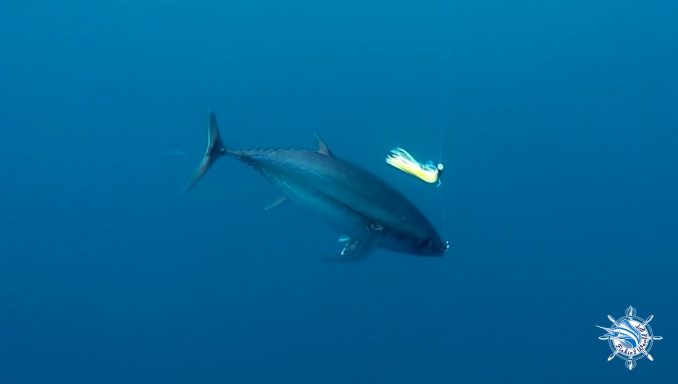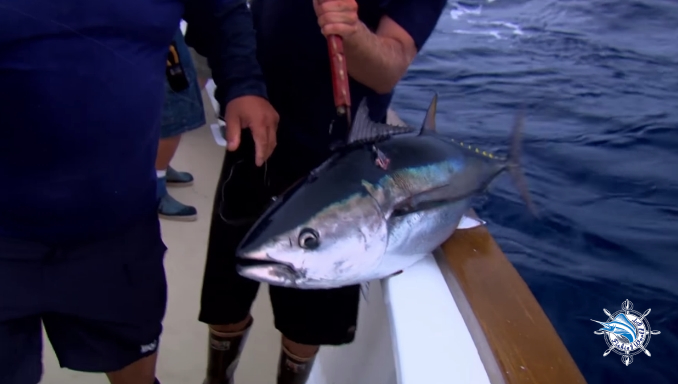For every angler, catching a tuna is a very proud result. Because tuna is a very difficult fish to catch, they have an average weight of about 150kg. Therefore, the angler needs to be experienced and have great strength to catch tuna.
How long does it take to reel in a tuna? It can take anywhere from 30 minutes to 4 or 5 hours when those boats hook up a tuna. It’s no easy task getting those fish to the boat, and there are a lot of days when the fish wins. So is there any technique to catch a mature tunaa with the least chance of failure? Definitely yes, and I will help you understand how to catch a tuna correctly.
I already have an article on the topic of How to reel fish? You can refer to it here How To Reel In A Fish?
How many types of tuna are there?
Tuna is a large fish of the family Scombridae, mainly of the genus Thunnus, living in warm seas, about 185 km from the shore. Tuna is especially delicious seafood with very healthy eyes (bigeye tuna), processed into various delicious dishes and created a valuable source of export goods.
But to mention, there are 9 species of the genus Thunnus: 5 species of tuna that every angler should know:
- The albacore has an elongate, fusiform body with a conical snout, large eyes, and remarkably long pectoral fins. Its body is a deep blue dorsally and shades of silvery-white ventrally. The albacore is a very economically important fish and targets commercial and recreational fisheries.
- Atlantic bluefin tuna have been recorded at up to 680 kg (1,500 lb) in weight and rival the black marlin, blue marlin, and swordfish as the largest Perciformes. Bluefins are a top favorite among anglers. Bluefins have been one of the most important big-game species sought by sports seekers in America, Spain, Canada, France, and Italy.
- Skipjack tuna is an important commercial and game fish. It is a streamlined, fast-swimming pelagic fish, common in tropical waters throughout the world. It commonly reaches fork lengths up to 80 cm (2 ft 7 in) and a mass of 8–10 kg (18–22 lb).
- The yellowfin tuna is among the larger tuna species, reaching weights over 180 kg (400 lb), but is significantly smaller than the Atlantic and Pacific bluefin tunas, which can reach over 450 kg (990 lb), and slightly smaller than the bigeye tuna and the southern bluefin tunas.
- Bigeye tuna can grow up to 250 centimeters (98 inches) or 8 feet in length. The maximum weight of individuals probably exceeds 180 kg (400 lb), with the all-tackle angling record standing at 178 kg (392 lb). They are large, deep-bodied, streamlined fish with large heads and eyes.

How to reel in a tuna
I’m going to show you how to reel in a bluefin tuna properly. First off, as soon as I usually hit, they’re going to start peeling line off, and they start running. Let them run. Tuna will tend to swim to the bottom when hooked. As soon as that line stops, stop taking it out and drag stuff going. You want to crank it if you could crank hard with your arm and do it. Crank crank crank when they start getting up and down. These are putting some weight on it. Then you’re going to use your left hand. Most people use the above. I highly recommend you use a glove. You pull the line into you and crank it at the same time. You pull the line, and with one hand, you reel until the fish is above the water.
You have to understand that the key to catching a tuna is to tire them out. This is a game of wits between you and the fish. If you spend less effort than the fish, you will win. You have to make the decision when to reel and when to stop.
– If the fish runs away from the boat, let them run. Your job is to keep the line. By the time they get tired, you will see a decrease in traction. You have to spin and pull them closer quickly.
– If the fish runs back to the boat, quickly spin the reel to pull the line.
– If the fish is pulled close to the boat, it will panic. Be careful with their sudden swings, although they are very tired now.
Check out this article to better understand how to fight them: How To Reel In A Fish?

What type of reel should be for tuna?
There are many conventional types that can do this, but from personal experience, I recommend to you two types of fishing reels, Penn Squall and Fathom. You can learn more about them in the following article: Penn Squall Vs Fathom
Last update on 2024-08-08 / Affiliate links / Images from Amazon Product Advertising API Last update on 2024-08-07 / Affiliate links / Images from Amazon Product Advertising API
Questions & Answers
How much is a tuna worth? – It’s reported that the finest Bluefin Tunas can be valued at around $220 per pound. In 2020, a perfect and giant 600-pound Bluefin sold for $3 million in Tokyo, Japan.
What size is the biggest tuna ever caught? – There have been several giant Atlantic bluefin tunas catches in recent history. The largest fish belongs to fisherman Ken Fraser, who caught a bluefin tuna off Nova Scotia, Canada, in 1979. That fish weighed a staggering 1,496 pounds!
Conclusion
To catch a large tuna is not an easy task. You have to be a skilled and strong angler to be able to do that.
You already have the answer to the “How long does it take to reel in a tuna?”. Remember, everything depends on your personal preferences. Any reels are expensive or cheap, it will still be useless if you can’t master them.
I hope this article is helpful to you. Do you have another idea?
Further reading:
- Other info about fishing in Fishingandhuntingsports
- Fishing reel Wikipedia
- A Belfast fisherman accidentally caught a 600-pound tuna



